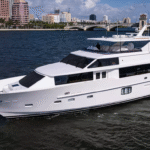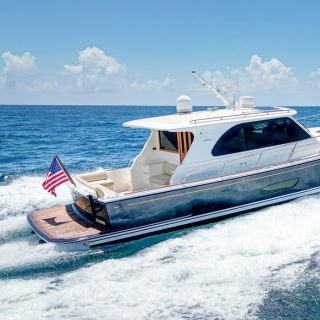
Is Yachting Experiencing Its First UHNW Class Divide?
By
Andrew Miles, President
Miles Yacht Group
Palm Beach, FL
In every era, the yachting market mirrors the world’s wealth structure—and in 2025, that reflection has never been sharper. The luxury yacht sector, once buoyed by a universal tide of affluence, is now fracturing along distinct economic and psychological lines. Beneath the polished chrome and glass of
shipyards and brokerage gleeful promotion, four entirely different worlds have emerged: the fast-moving sub–$3 million buyer class, the stagnant mid-tiers between $3 million and $10 million, the $10 million to $30 million, and the stratospheric 50-meter-plus market that now operates as its own
sovereign economy.
The New Geometry of Wealth
The under–$3 million market—dominated by buyers of 30- to 60-foot production yachts—has remained remarkably active. These owners are often cash buyers, motivated not by markets but by lifestyle, seeking immediate enjoyment rather than investment. Conversely, no matter where you land in the
$3 million to $30 million range, the business has slowed to a cautious crawl. Traditionally, these buyers form the engine of brokerage activity: self-made entrepreneurs, regional developers, automotive dealership owners, and industrial suppliers—the backbone of high-net-worth (HNW) yachting.
But the stall in this tier isn’t about financing—few in this bracket ever needed loans. Instead, it’s about confidence. Many of these owners lead companies tied to consumer sentiment: home construction, automotive retail, building materials, and high-end services. When the phone stops ringing and their managers aren’t reporting record months, instinct takes over. Whether they have $30 million or $300 million in liquidity, they pull back. As J.P. Morgan’s 2025 Business Leaders Outlook confirms, mid-
market executives report high confidence in their own operations but deep anxiety about the broader economic horizon. As I have long summarized, “The mood is worth more than the money.”
Global Forces and the Great Decoupling
That mood is shaped by a turbulent backdrop. The global economy, rocked by tariff escalation, double-digit government debt growth, and regional conflicts, has created a paradox of vast nominal wealth amid shrinking confidence. Tariff revenues in the United States hit record highs this year while inflationary currents persist. Precious metals and crypto assets surged—gold passing record thresholds in October and crypto millionaires increasing 40% year-over-year. The ultra-rich responded not by retreating from spending but by redirecting it toward assets that can move, appreciate, or project permanence.
It is this environment that fuels the continued strength of the 50-meter-plus market. These buyers—true Ultra High Net Worth Individuals (UHNWIs)—increasingly view yachts as sovereign assets: mobile family offices, refuge platforms, even strategic floating estates insulated from regulatory reach. Charter markets thrive under their influence. In 2025, the global luxury charter sector exceeded $17 billion, offering turnkey access to experiences without operational overhead expense burdens. For many at the pinnacle of affluence, chartering is no longer a trial before ownership—it is ownership redefined.
The Psychology of Disconnection
The result is a layered ecosystem where momentum at the bottom and resilience at the top leave the
middle hollow. Bain’s most recent luxury report identifies confidence—not liquidity—as the single most
important variable in discretionary spending. When business owners sense contraction in their own
industries, they instinctively conserve, even when balance sheets are strong. This behavioral reflex
repeats across nearly every luxury category—yachts, cars, art, and jewelry—but it is amplified in
yachting by the emotional scale of the purchase.
Meanwhile, UHNW buyers operate in a world detached from these feedback loops. Their assets are
denominated across currencies, jurisdictions, and vaults—not payrolls. For them, a superyacht is not a
purchase but an extension of strategy, privacy, and control. They dwell above the turbulence, yet the
very act of doing so widens the divide.
The Market’s Divided Horizon
YATCO’s 2025 global yacht market forecast highlights this divergence clearly: younger UHNWI buyers
and new international wealth from the Middle East and Asia continue to fuel the expansion of the large-
yacht segment. Shipyards such as Feadship, Lürssen, and Benetti are booked years ahead, constructing
floating cities with AI control, hybrid propulsion, and cybersecure office suites. Meanwhile, brokerage
listings between $3 million and $30 million lengthen their days on market.
At its core, this is not a simple supply-demand mismatch. It’s a confidence divide fueled by macroscale
instability and microscale psychology. The under–$3 million segment thrives on lifestyle immediacy, the
mid-tier withdraws in introspection, and the 50-meter plus realm transcends conventional economics
entirely.
An Industry at a Crossroads
Global yachting stands at a historic intersection between access and ownership, optimism and caution.
The once-continuous gradient of luxury has split into isolated strata of behavior and identity. For the
first time in modern memory, the yachting world reflects not the unity of wealth—but its fragmentation.
So yes, Is Yachting Experiencing Its First UHNW Class Divide? feels precisely right. And the answer is not
just yes—it already has. The evidence is everywhere: in the mood charts of entrepreneurs, in the
booking sheets of charter firms, in the shipyard order books, and in the silent pauses before HNW clients
say, “Let’s wait until next year.”













